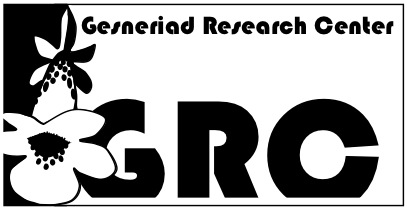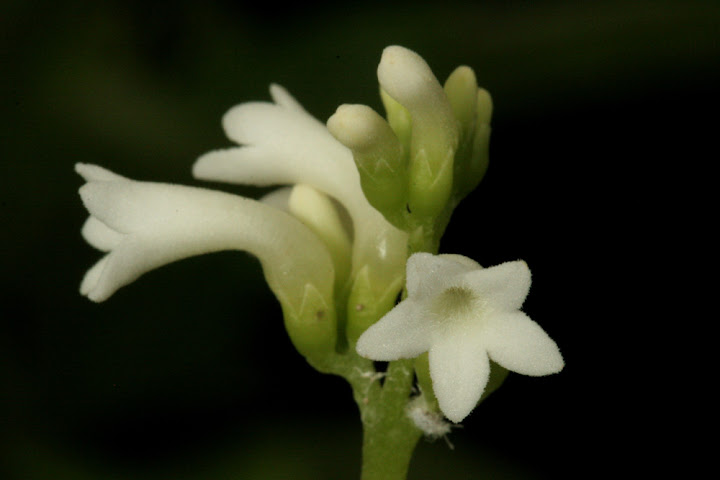28 August 2009
Frequently Asked Questions about the GRC
Gesneriad Research Center at Selby Gardens
Frequently Asked Questions (FAQ)
What is the Gesneriad Research Center (GRC)?
The GRC is the center in North America for botanical research on the plant family Gesneriaceae. The mission of the GRC is to increase and diffuse knowledge of the flowering plant family Gesneriaceae through exploration, research, professional collaborations, and education, and to facilitate conservation initiatives that benefit gesneriads and the tropical ecosystems where they occur.
Why study gesneriads?
Formally recognized as the plant family Gesneriaceae in 1816, gesneriads have captured the attention of botanists, explorers, and plant enthusiasts for centuries. Gesneriads are often quite striking with a wide range of growth forms, flower colors, and fruit types. They are significant ecologically for their pollinators and seed dispersal interactions as well as for their adaptations to specialized habits such as epiphytism. Gesneriads comprise a major portion of diversity in tropical forests, and many are exceptional horticultural subjects.
Why is the GRC at Selby Gardens?
Marie Selby Botanical Gardens (est. 1973) has been involved with gesneriad research since its inception, as is evident from the Gardens’ official seal that illustrates a bromeliad, an orchid, and a gesneriad. Dr. Hans Wiehler was the driving force behind Selby’s early gesneriad program, helping to build the living and preserved collections during his tenure there. In 2002, Wiehler donated the several thousand herbarium specimens, liquid-preserved specimens and other resources of the Gesneriad Research Foundation (GRF) to Selby Gardens. A dedicated gesneriad research program was established to curate, manage and utilize the newly acquired gesneriad resources at Selby Gardens and to further the legacy established by Dr. Wiehler.
How is the GRC funded?
The GRC is currently funded through charitable contributions from individuals, an annual grant from The Gesneriad Society, Inc., and through competitive grants (most recently through an award from the Institute of Museum and Library Services). Selby Gardens, while not directly funding the GRC, generously provides essential overhead and space for GRC operations including office, lab, herbarium and greenhouse.
How are GRC funds managed?
Contributions are managed in two ways: 1) Selby Gardens maintains a designated account for GRC related contributions and grants; all monies in this account are used exclusively for GRC related activities; 2) The Gesneriad Society has set up the GRC Fund to accumulate and distribute funds to the GRC; the goal of this fund is to ultimately raise enough contributions for the endowment of the GRC.
Who is the GRC?
Director: Dr. John R. Clark; GRC Senior Advisory Committee: Dr. Larry Skog (Smithsonian), Dr. Eric Roalson (Washington State University), Dr. John L. Clark (University of Alabama); Selby Senior Staff Advisor: Bruce Holst; Core Volunteers and Supporters*: Karyn Cichocki, Nancy Kast, Jeanne Katzenstein, JoAnne Martinez, Melissa McDowell, Donna Pound, Bill Price, Carolyn Ripps, Doug Rist, Marge Schmiel, Paul Susi, Jim Sciarello, Anne Vidaver; Affiliated organizations: Marie Selby Botanical Gardens, The Gesneriad Society, Inc., Suncoast Chapter of the Gesneriad Society, Tampa Bay Chapter of the Gesneriad Society, Frelinghuysen Arboretum Chapter of the Gesneriad Society.
*Listed alphabetically; list includes volunteers and financial contributors of $100 or more. If you see any omissions, please notify John R. Clark at johnrobertclark@gmail.com
Who do I contact for more information about the GRC?
Contact: Dr. John R. Clark, Director, Gesneriad Research Center, Marie Selby Botanical Gardens, 811 S. Palm Ave., Sarasota, FL 34236; 941.366.5731x256; jrclark@selby.org or johnrobertclark@gmail.com.
14 August 2009
MARIE SELBY BOTANICAL GARDENS 811 SOUTH PALM AVE. SARASOTA FLORIDA 34236
941-366-5731 941-366-9807 FAX WWW.SELBY.ORG
FOR IMMEDIATE RELEASE
Contact: Dr. John R. Clark, Head of Molecular Programs, (941) 366-5731 x 256, jrclark@selby.orgIMLS Contact: Jeannine Mjoseth, (202) 653-4632, jmjoseth@imls.gov
Selby Contact: Debbie Steele, Director of Marketing, (941) 366-5731 x 225, dsteele@selby.org
Marie Selby Botanical Gardens Awarded Prestigious Grant
from the Institute of Museum and Library Services
(August 14, 2009 – Sarasota, FL): Thanks to a grant of $133,025 from the federal Institute of Museum and Library Services (IMLS), Selby Gardens’ Center for Tropical Plant Sciences and Conservation jumps into the 21st Century with the establishment of its new Molecular Research Program. This new program, a two-year start-up project, will provide Selby scientists with cutting-edge resources needed to conduct plant identification, classification and conservation research.
Dr. John R. Clark, Head of Molecular Programs and Director of the Gesneriad Research Center at Selby Gardens says, “Molecular research capabilities, using DNA to understand the relationships between organisms, allows us to address critical questions about plant evolution and conservation, questions that concern the identity and origin of the plants we study. Think of it as CSI meets Selby Gardens where botanists, instead of forensic scientists, use DNA to identify and ultimately conserve plants.”
Epiphytes are a diverse group of plants that live on other plants and warrant continued research based on their high scientific and economic importance. Dr. Clark and other Selby scientists will conduct molecular-based studies on the plant families Gesneriaceae and Orchidaceae, two focal research plant groups at Marie Selby Botanical Gardens. These research projects will address relevant questions in epiphyte diversification and conservation, and utilize molecular-based methods in conjunction with traditional techniques to answer them.
Bruce Holst, Director of Research at Selby Gardens, states, “The new Molecular Program is vital to Selby Gardens’ ongoing commitment to science and conservation. This grant and the projects it supports are a major step forward in achieving Selby Gardens’ goal of being the leading institution for advancing the scientific understanding of epiphytes.”
The new Molecular Research Program will be based in Selby’s existing research facilities. The IMLS Grant will provide funding to equip the new program as well as salary and research budget support for Gardens scientists for two years.
The Institute of Museum and Library Services is the primary source of federal support for the nation’s 123,000 libraries and 17,500 museums. The Institute's mission is to create strong libraries and museums that connect people to information and ideas. The Institute works at the national level and in coordination with state and local organizations to sustain heritage, culture, and knowledge, enhance learning and innovation, and support professional development. To learn more about the Institute, visit www.imls.gov.
Marie Selby Botanical Gardens is a respected center for research and education as well as a famous orchid showplace. The Gardens is located at 900 South Palm Avenue in Sarasota, Florida. It is open to the public daily from 10:00 a.m. to 5:00 p.m. with the exception of Christmas day. For further information call (941) 366-5731 or visit www.selby.org.
# # #
04 August 2009
A brief update on living gesneriad collections at Selby
Thanks to Atlanta Botanical Garden, and numerous growers in The Gesneriad Society including Nancy Kast, Jeanne Katzenstein, JoAnne Martinez, Melissa McDowell, and Bill Price, Selby Gardens has a far more diverse collection of gesneriads than it did a year ago. These and other supporters have donated cuttings and sometimes whole plants to bolster the Gardens' collection for education and display.
Recently, Jeanne, Melissa and I, with the assistance of Gail McDaniel - Greenhouse Collections Horticulturalist, repotted and accessioned nearly 40 new specimens into Selby's living collection.

~~~~~~~
A recent trip by Selby Gardens scientist Wes Higgins (Guatemala 2009) has also resulted in new gesneriad collections in cultivation at Selby.
On my recent trip to the Solomons, sponsored by Dr. Anne Vidaver, I was able to collect live specimens of at least five different species of Cyrtandra.
~~~~~~~
Existing accessions at Selby
Selby Gardens has maintained a collection of gesneriads since its inception back in the early 1970s. The facilities are often ideal for growing species requiring high temperature and humidity. Larger shrubs and tree gesneriads can also reach their full potential in the large greenhouses of the Gardens.


